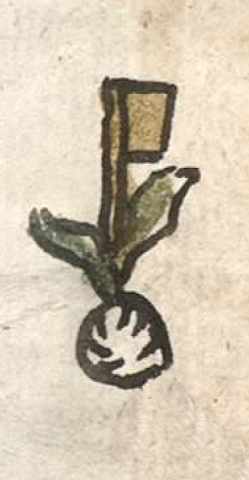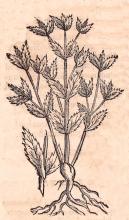Acapa (CmpRG)
This is a compound glyph for the personal name Acapa, attested here as a man’s name. It is one of three obvious name glyphs found on the 1580 Relación Geográfica de Cempoala (Hidalgo). There are two plausible analyses of the glyph. One is that it consists of a banner (panitl) protruding from a reed-like plant (acatl) which in turn arises out of an element that may be a white ball of down. The down feather or feathers play no obvious linguistic role in the indicated name, although it could be a semantic indicator for acatl. If this is the correct analysis, then, acatl supplies the first syllable of the name, while the panitl gives the second. Barbara Mundy (see below) has also suggested this interpretation. However, while several examples of acatl from the Codex Mendoza show reeds associated with down feathers, there are also eagle wing feathers rising above them (see below), an element lacking in the present example. The second possible analysis of the glyph is that it depicts a Mexican medicinal plant with the Nahuatl name acapatli, which without its absolutive would produce the whole word found here unaided. As such, the panitl element would serve as a phonetic complement for the -pa (toward) part of the name. If not a down feather, that element might instead be a root ball or a tuber that has a medicinal role. The glyph is outlined in black, with the banner facing right and shaded in brownish yellow. The two leaves of the reed are green, while the feather ball (if that is what it is) is white with black lines in its interior may suggest a feathery nature.
Robert Haskett
This compound glyph for Acapa (the name of a medicinal plant) here names a male individual. It is one of three such elements found on the map (a fourth person wearing similar attire lacks an alphabetic gloss and is not clearly linked to a glyph naming him, though there are two possibilities nearby. All three of the men with glyphic names, but not Spanish titles or “Christian” first names, are dressed in what seem to be animal pelts of some kind (see the historical contextualizing image). This suggests that they are figures from the far past or possibly members of another ethnic group (Nahua lords living at the time of the map’s creation are shown seated on indigenous-style icpalli (thrones) wearing elite cotton garments and with noble diadems on their heads). For instance, Barbara Mundy suggests that they are Otomies rather than Nahuas. The Spanish text of the Relación states that Otomí peoples did live in the area, such as in or around the cabecera of Tlaquilpa. Another possibility is that they are among “algunos chichimecos que quere decir gente bárbara” (“some Chichimecos, which means ‘barbarians’”) who speak Nahuatl and live in two of Cempoala’s four cabeceras (Tzacuala and Tecpilpan). Whatever the case, Acapa is situated above another, similar figure glossed as Cuazcotzin. Both of them are seen not too far below the lower left edge of the large place glyph for Cempohuallan. Turning to the puzzle of Acapa’s name glyph, the possibility that it instead could be based on the medicinal plant, acapatli (also spelled acapahtli, with "h" for the glottal stop) finds some support from such sources as Dr. Francisco Hernández’s sixteenth-century natural history of New Spain, the so-called Mexican Treasury. In it, he describes the acapatli as a plant standing “the height of a man” with “hollow, smooth and square stems,” and leaves somewhat like radishes “but crenellated at the edge like a saw.” The leaves, when “crushed and applied . . . reduce the spleen and soothe its pain.” [See: Dr. Francisco Hernández, Rerum medicarum Novae Hispaniae thesaurus, seu, Plantarum animalium mineralium Mexicanorum historia (also known as The Mexican Treasury; Rome: Vitale Mascardi, 1651); see also Simon Varey, Sed., The Mexican Treasure: The Writings of Dr. Francisco Hernández (Stanford: Stanford University Press, 2000; and UNAM). An early eighteenth-century book by the Irish-born, England-based naturalist Sir Hans Slone, who borrows heavily from Hernández’s description of the plant (Natural History, vol. 1, 1707, 135), describes its woody stem being used “to strike fire, if held between the knees, and a hard flick with a tapering point turned round in it by the hands.” Nahuatl glyphs meaning “fire drill” (mamalhuaztli (see below) in the Codex Mendoza seem to be referring to the acatl in the form of an arrow, with the feather elements attached to them. If Sloane’s description of the use of stalks of the acapatli for fire drilling is correct, then the presence of the round white element in the glyph could perhaps signal that function, as well. For a study of the Relación (which, however, does not mention these particular figures), see Mundy, Barbara E., “Mapping Babel: A Sixteenth-Century Indigenous Map from Mexico,” The Appendix, 1:4 (October 2013), https://theappendix.net/issues/2013/10/mapping-babel-a-sixteenth-century... Mundy (1996), 132, analyzes and discusses Acapa and the other three similar figures, and see also Ballesteros García (2005), 79. For information about the Indigenous communities in the Zempoala area see Gerhard, Peter, A Guide to the Historical Geography of New Spain (Cambridge: Cambridge University Press, 1972), 67-69.
Editor's note: Acapan is a place name in another record in this collection. (SW)
Robert Haskett
acapa
Acapa
Robert Haskett
1580
Robert Haskett
personal name, nombre, reed, caña, banner, bandera, medicinal plant, planta medicinal, feathers, plumas
Source: Hernández, Dr. Francisco, Rerum medicarum Novae Hispaniae thesaurus, seu, Plantarum animalium mineralium Mexicanorum historia (also known as The Mexican Treasury; Rome : Vitale Mascardi, 1651), https://www.loc.gov/item/2021667095/

aca(tl), reed or cane, https://nahuatl.wired-humanities.org/content/acatl
pani(tl), flag or banner, https://nahuatl.wired-humanities.org/content/panitl
acapa(tli), medicinal plant with radish-like leaves, https://nahuatl.wired-humanities.org/content/acapatli
Relación de Cempoala - University of Texas Libraries Collections. 1580-11-01. https://collections.lib.utexas.edu/catalog/utblac:f87917e2-e3c9-4eb2-a83...
Materials that are in the public domain (such as most of the maps in the PCL Map Collection) are not copyrighted, and no permission is needed to copy them. You may download them and use them as you wish. The image appears here courtesy of the University of Texas Libraries, The University of Texas at Austin. If you do publish anything from this database, please cite the Visual Lexicon of Aztec Hieroglyphs.









